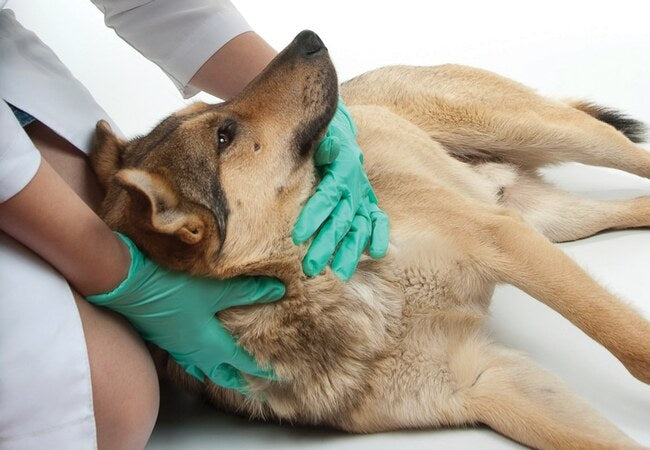Vet’s 2025 Guide to Canine Cardiogenic Shock Recognition, Treatment & Recovery🩺

In this article
Vet’s 2025 Guide to Canine Cardiogenic Shock Recognition, Treatment & Recovery🩺
By Dr. Duncan Houston BVSc
💡 What Is Cardiogenic Shock?
Cardiogenic shock is a life-threatening emergency where the dog’s heart is too weak or blocked to pump sufficient blood, leading to dangerously low blood pressure, inadequate tissue oxygenation, organ dysfunction, and collapse.
🚩 Common Causes
- Severe myocardial disease (dilated cardiomyopathy, myocarditis).
- Severe valvular disease or acute mitral chord rupture.
- Pericardial effusion → heart tamponade.
- Life-threatening arrhythmias (ventricular tachycardia, bradyarrhythmias).
- Secondary pump failure (e.g., sepsis, pulmonary embolus).
👀 Clinical Signs
- Pale or bluish mucous membranes, prolonged capillary refill (>2 sec), weak pulses.
- Cold extremities, cool paws.
- Tachycardia or severe arrhythmia, tachypnea and harsh lung sounds or crackles.
- Weakness, collapse, altered mentation or syncope.
- In some cases, cough or respiratory distress if pulmonary edema is present.
🧪 Diagnostics
- Physical exam: BP measurement, ECG, pulse quality, lung auscultation.
- Thoracic X‑rays: cardiomegaly, pulmonary edema, pericardial fluid.
- Echocardiography: evaluates myocardial function, chamber size, valve competence, effusions.
- ECG: identifies arrhythmias or electrical activity abnormalities.
- Bloodwork: CBC, chemistry, electrolytes to detect organ dysfunction or contributing conditions.
- Focused ultrasound (FAST): quick evaluation for pericardial effusion in emergencies.
🏥 Emergency Stabilization
Treatment is ICU-level and may begin even before full diagnostics are complete:
1. Oxygen & Respiratory Support
- Administer oxygen via mask, nasal cannula, or cage.
- In severe pulmonary edema or respiratory compromise, consider intubation and mechanical ventilation.
2. Drain Pericardial Effusion (if tamponade)
- Pericardiocentesis may rapidly improve cardiac filling and output.
3. Diuretics to Reduce Volume Overload
- Administer loop diuretics (e.g., furosemide) to remove excess fluid and relieve pulmonary edema.
4. Inotropes & Vasodilators
- Dobutamine or pimobendan to support contractility and reduce afterload.
- Sodium nitroprusside may be combined with dobutamine under careful monitoring.
5. Cautious Fluid Therapy
- Small fluid boluses (10–20 ml/kg) may help with preload, but avoid overload.
6. Vasopressors for Refractory Hypotension
- Norepinephrine or vasopressin may be used if BP remains low despite inotropes.
7. Anti‑Arrhythmic Care
- Treat serious arrhythmias with drugs like diltiazem, atenolol, or sotalol.
- Immediate electrical cardioversion may be lifesaving for ventricular tachycardia or fibrillation.
🩺 Monitoring & Critical Care Support
- Continuous ECG, invasive blood pressure, pulse oximetry, respiratory rate, and urine output.
- Frequent reassessment of lung sounds, perfusion, mentation.
- Ongoing evaluation with echo as the condition improves.
- Repeat labs for electrolytes, renal function, and acid-base balance.
- Support measures: antiemetics, analgesia, temperature control.
📈 Prognosis & Outcomes
- Guarded prognosis—high risk of mortality if not treated rapidly.
- Outcome depends on cause: pericardial tamponade or arrhythmias offer better survival with quick action.
- Chronic cardiac disease may require long-term meds (ACE inhibitors, pimobendan, diuretics) to stabilize.
- Close post-crisis monitoring is essential to detect recurrence or complications.
🚫 Preventive & Owner‑Level Care
- Regular cardiologist checks for dogs with heart disease (echo, ECG).
- Early treatment of arrhythmias, pericardial effusion, and valvular disease.
- Weight control, low-sodium diet, exercise moderation.
- Prompt response to early warning signs—coughing, lethargy, collapse.
🏡 Ask A Vet App Home‑Support Tools
- 🗓 Medication reminders: diuretics, ACE inhibitors, pimobendan, anti-arrhythmics.
- 📊 Logs: pulse, respiratory rate, activity tolerance, appetite.
- 📸 Upload photos/videos: gait, breathing, mucous membrane color.
- 🔔 Alerts: coughing, collapse, breathing changes, decreased appetite.
- 📚 Built-in guides: emergency signs, heart medication schedules, dietary advice.
🔑 Key Takeaways
- Cardiogenic shock is acute, dangerous heart pump failure—characterized by low flow and organ hypoperfusion.
- Signs include cold, pale gums, collapse, weak pulses, tachycardia, and respiratory distress.
- Diagnosis with ECG, echo, X‑rays, labs, and FAST scan.
- Emergency treatment includes oxygen, pericardiocentesis, diuretics, inotropes, vasopressors, cautious fluids, and arrhythmia control.
- ICU monitoring and addressing underlying heart disease or arrhythmia are essential.
- Ask A Vet app empowers owners to support recovery with tracking, medication reminders, and alerts.
🩺 Final Thoughts ❤️
In 2025, aggressive emergency care—including pericardial drainage, precise use of inotropes and diuretics, ICU support, and advanced imaging—has improved the outlook for dogs in cardiogenic shock. Long‑term success hinges on ongoing cardiac management and vigilant home‑based monitoring via the Ask A Vet app. With swift action, expertise, and structured support, dogs can survive this crisis and go on to live comfortable lives. 🐾✨
Visit AskAVet.com and download the Ask A Vet app to log medications, record vitals, upload signs, schedule follow-ups, and receive expert support anytime—right from your phone. 📲






